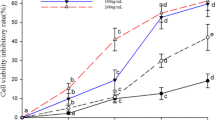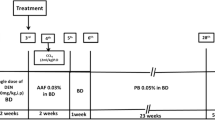Abstract
Purpose: The antiproliferative effect of high concentrations of ethanol (80–100 mmol) on liver carcinoma is well known. However, the high concentrations of ethanol affect both tumor cells and normal hepatocytes. The present study was designed to determine the effect of low ethanol concentrations (0–10 mmol) on cell proliferation and cell death (apoptosis and necrosis) in a human tumor cell line HepG2 and in normal rat hepatocytes. Methods: Primary cultures of normal rat hepatocytes and HepG2 cells cultures were used. Cells were incubated with increasing ethanol concentrations or without ethanol (control group) for 24 h and analyzed immediately (group I) or after an additional incubation time of 48 h without additional ethanol application (group II). Cell proliferation was determined by assessing 5-bromo-2′-deoxyuridine (BrdU) incorporation. Apoptosis was assessed by means of DNA fragmentation and cysteine aspartate-specific protease (caspase-3) activity. Necrosis was analyzed by quantification of lactate dehydrogenase (LDH) release into culture medium. Results: Twenty-four h exposure to 1 mmol ethanol inhibited cell proliferation in HepG2 cells by 75% (P < 0.05), while it remained unaltered in rat hepatocytes. The effect of ethanol persisted for another 48 h where cell proliferation was 5% of control in HepG2 cells and 70% of control in rat hepatocytes (P < 0.005). After 24 h incubation with 1 mmol ethanol 28% of HepG2 cells and 12% of rat hepatocytes showed DNA fragmentation as sign of apoptosis (P < 0.001). In group II 39% of HepG2 cells and 26% of rat hepatocytes were apoptotic (P < 0.001). Caspase-3 activation progressively increased after ethanol treatment in HepG2 cells and rat hepatocytes. The first significant difference was observed after 4 h (activity in HepG2 was 68% higher than in rat hepatocytes) and was maximum after 10 to 12 h where the activity in HepG2 was 180% of the activity in rat hepatocytes. Lactate dehydrogenase release into culture medium as an indicator of necrosis in HepG2 cells, increased from 0.5% in group I to 12% in group II, and from 0.1% to 8% in rat hepatocytes (P < 0.005). Increasing ethanol concentration to 10 mmol increased necrosis to 75% in HepG2 cells, and to 45% in rat hepatocytes (P < 0.05) whereas the effects on cell proliferation and apoptosis were not significantly different. Conclusions: Small ethanol concentrations (equivalent to 1 mmol) inhibit cell proliferation and increase apoptosis more strongly in HepG2 cells than in normal rat hepatocytes. These findings suggest the use of 1 mmol ethanol as a treatment for hepatocellular carcinoma because this mainly affects tumor cells but not surrounding normal tissue.
Similar content being viewed by others
Author information
Authors and Affiliations
Additional information
Received: 24 November 1999 / Accepted: 25 February 2000
Rights and permissions
About this article
Cite this article
Castañeda, F., Kinne, R. Cytotoxicity of millimolar concentrations of ethanol on HepG2 human tumor cell line compared to normal rat hepatocytes in vitro. J Cancer Res Clin Oncol 126, 503–510 (2000). https://doi.org/10.1007/s004320000119
Issue Date:
DOI: https://doi.org/10.1007/s004320000119




